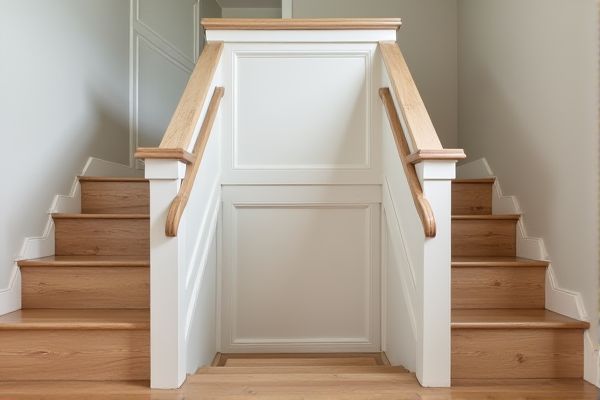
Choosing between concealed fastener and exposed fastener stairs impacts both the aesthetics and safety of your staircase, with concealed fasteners offering a sleek, modern look while exposed fasteners provide a more traditional and easier-to-maintain option. To understand which fastening method best suits your needs and preferences, explore the detailed comparison in the rest of the article.
Table of Comparison
| Feature | Concealed Fastener Stairs | Exposed Fastener Stairs |
|---|---|---|
| Appearance | Sleek, clean look with fasteners hidden | Visible screws or nails on tread surface |
| Safety | Reduced tripping hazards, smooth surface | Potential snag points due to exposed hardware |
| Durability | Protected fasteners resist corrosion | Fasteners more exposed to weather and wear |
| Installation | More complex, requires special tools or clips | Simple and quick with standard screws or nails |
| Maintenance | Less frequent due to fastener protection | Fasteners may loosen or corrode, needing upkeep |
| Cost | Typically higher due to hardware and labor | Usually lower upfront cost and installation time |
Introduction to Stair Fastening Systems
Concealed fastener stairs use hidden hardware to secure treads and risers, creating a clean, seamless appearance that enhances safety by reducing trip hazards. Exposed fastener stairs rely on visible screws or nails, offering easier installation and maintenance but with a more industrial look. Both systems must meet structural standards for load-bearing capacity and durability to ensure stair safety and longevity.
What Are Concealed Fastener Stairs?
Concealed fastener stairs feature fastening systems hidden beneath the stair components, providing a sleek and uninterrupted surface that enhances aesthetic appeal and reduces trip hazards. These stairs typically use clips, brackets, or specialized screws installed underneath or behind treads and risers, offering increased durability and protection from weather elements. Common in high-end residential and commercial applications, concealed fastener stairs require precise installation but deliver a clean, modern finish compared to traditional exposed fastener systems.
What Are Exposed Fastener Stairs?
Exposed fastener stairs use visible screws or nails to attach treads and risers, offering straightforward installation and easy maintenance. This design allows for quick inspections and replacements but may require regular upkeep to prevent corrosion or wear. If you prefer a traditional look with simple installation, exposed fastener stairs could be the right choice for your project.
Aesthetic Differences: Concealed vs Exposed Fasteners
Concealed fasteners create a sleek, seamless appearance on stairs by hiding screws or nails beneath the surface, enhancing the overall aesthetic appeal and allowing the natural beauty of materials like wood or metal to stand out. Exposed fasteners, on the other hand, are visible and can add an industrial or rustic charm, but might disrupt the clean lines and smooth finish that many homeowners desire. Your choice between concealed and exposed fasteners will significantly influence the visual style and perceived quality of your staircase design.
Installation Process Comparison
Concealed fastener stairs require a more intricate installation process involving hidden clips or brackets that secure treads and risers without visible screws, enhancing aesthetics and reducing tripping hazards. Exposed fastener stairs feature straightforward installation using screws or nails driven directly through the material, offering quicker assembly but less sleek appearance and increased maintenance due to visible hardware. Overall, concealed fasteners demand precision and specialized tools, while exposed fasteners prioritize speed and simplicity in stair construction.
Durability and Maintenance Considerations
Concealed fastener stairs offer superior durability by protecting hardware from weather exposure, reducing the risk of corrosion and prolonging the lifespan of the stair structure. Maintenance requirements are generally lower for concealed fastener systems since the hidden components are less prone to dirt accumulation and damage. Exposed fastener stairs, while easier to inspect and replace components, often demand more frequent upkeep due to visible fasteners being susceptible to rust and wear from environmental factors.
Safety and Structural Integrity
Concealed fastener stairs enhance safety by eliminating protruding hardware, reducing trip hazards and surface wear, while maintaining a clean aesthetic. Exposed fastener stairs offer easier inspection and maintenance of structural components, allowing quick identification of loose or damaged fasteners critical for ensuring stability. Structural integrity in concealed fastener systems relies on hidden anchoring methods that distribute load evenly, whereas exposed fasteners provide direct mechanical fastening, both contributing to durable stair constructions when properly installed.
Cost Comparison: Concealed vs Exposed Fasteners
Concealed fastener stairs typically involve higher upfront costs due to specialized installation and materials, while exposed fastener stairs are generally more budget-friendly with simpler assembly. Your choice depends on long-term maintenance savings versus immediate budget constraints, as concealed systems offer a cleaner look and reduced wear exposure but can be more expensive initially. Factoring in labor rates and material durability is essential when comparing the total cost between concealed and exposed fastener stair options.
Popular Applications and Use Cases
Concealed fastener stairs are popular in modern residential and commercial spaces where a clean, seamless aesthetic is desired, such as luxury homes and office lobbies. Exposed fastener stairs are commonly used in industrial settings, outdoor decks, and public infrastructure due to their ease of installation and maintenance. Your choice depends on whether you prioritize visual appeal or practical functionality in high-traffic or weather-exposed environments.
Choosing the Best Fastener System for Your Stairs
Choosing the best fastener system for stairs depends on factors such as aesthetics, durability, and maintenance. Concealed fasteners provide a clean, sleek appearance by hiding screws or nails beneath the stair material, reducing trip hazards and enhancing safety. Exposed fasteners offer easier installation and inspection but may require regular upkeep to prevent corrosion and maintain visual appeal.
 homyna.com
homyna.com